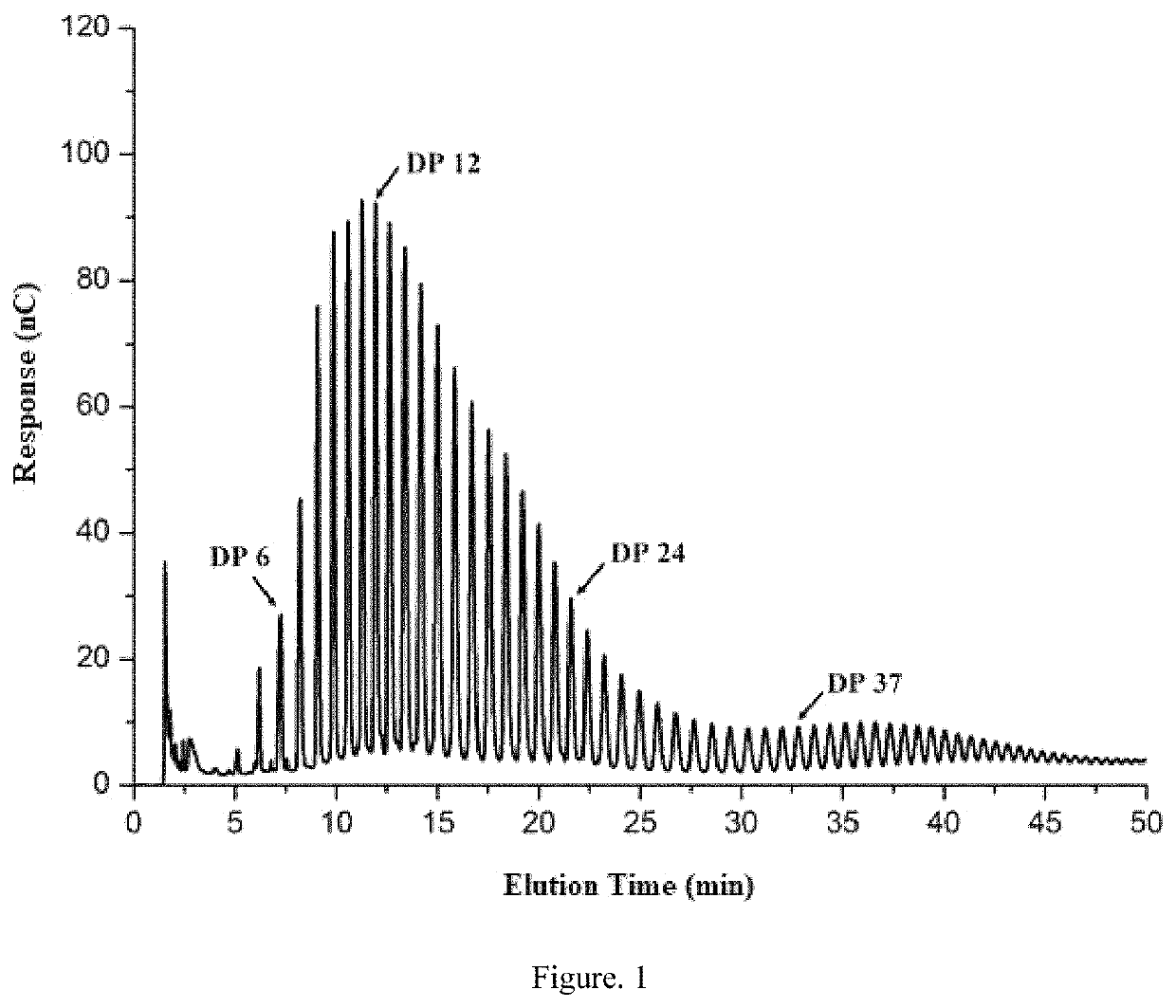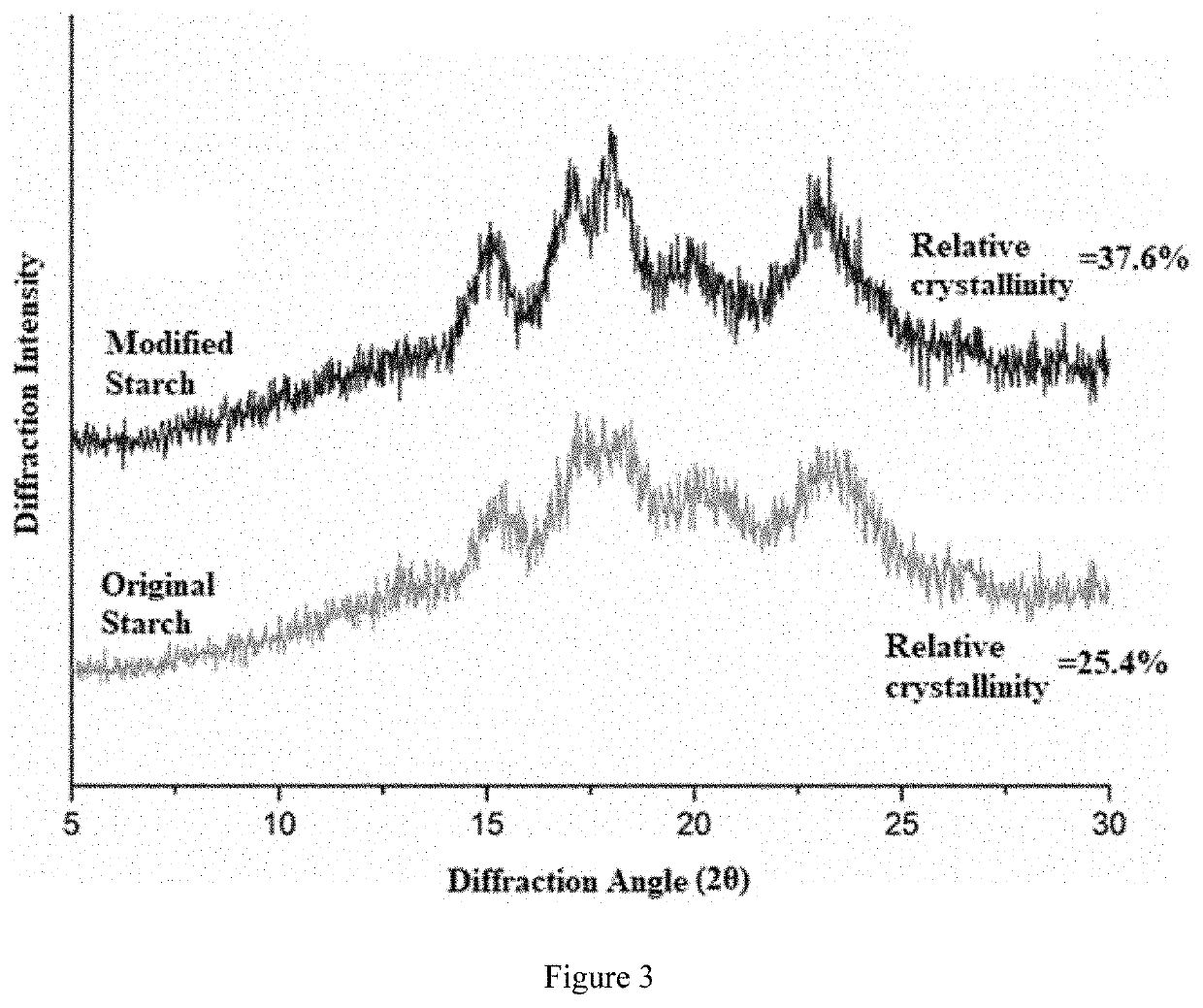Green preparation methods of rice resistant starch
a technology of resistant starch and green preparation method, which is applied in the direction of fertilization, etc., can solve the problems of starch granule collapse, favorable to the formation of resistant starch, and almost disappearance of the surface area, so as to shorten the outer branch length of the starch, reduce energy consumption, and high resistance starch content
- Summary
- Abstract
- Description
- Claims
- Application Information
AI Technical Summary
Benefits of technology
Problems solved by technology
Method used
Image
Examples
example 1
A Green Preparation Method of Rice Resistant Starch
[0030]It may include the following steps.
[0031](1) Preparation of rice starch suspension. 20 g (dry weight) of rice starch is weighed accurately, suspended in 200 mL of 0.02 mol / L sodium acetate buffer (pH 5.0, supplemented with 0.2 mL of 10% sodium azide), and stabilized in water bath for 0.5 hour at 50° C.
[0032](2) Enzymolysis with β-amylase. The rice starch suspension is mixed with 1,300 U / g β-amylase, oscillated in water bath for 2 hours at 50° C., and subsequently mixed with 3 mL of 1 mol / L NaOH solution to inactivate the enzyme to terminate the reaction, followed by adjusting the resulting enzymatic hydrolysate to pH 5.0 with isometric HCl at the same concentration.
[0033](3) Enzymolysis with glucosyltransferase. The enzymatic hydrolysate obtained in the previous step is mixed with 1,650 U / g glucosyltransferase, oscillated in water bath for 4 to 12 hours at 50° C., and subsequently mixed with 3 mL of 1 mol / L NaOH solution to in...
example 2
Using HPAEC-PAD to Analyze the Product Chain Length Distribution
[0039]A pretreated sample (25 μL) is injected into an HPAEC-PAD system and eluted at a flow rate of 1 mL / min. Two kinds of eluents used are 150 mM NaOH (A) and 500 mM sodium acetate in 150 mM NaOH (B), respectively. Gradient elution is conducted by mixing eluent B with eluent A. The resulting chain length distribution diagrams are shown in FIGS. 1 and 2, and the results are summarized in the following Table 1.
[0040]
TABLE 1Chain length distribution of an original starch and a modified starchChain length distribution ratio (%)AverageSampleDP DP 6-12DP 13-24DP 25-36DP ≥ 37chain lengthOriginal0.62 ± 0.0224.50 ± 0.03351.65 ± 0.0213.37 ± 0.029.86 ± 0.0321.37 ± 0.05StarchModified1.34 ± 0.0431.73 ± 0.02 48.87 ± 0.06 9.85 ± 0.108.21 ± 0.0916.48 ± 0.07Starch
[0041]It may be seen from Table 1 that the modified starch has more short chains and less relatively long chains, and the average chain length decreases significantly. The cha...
example 3
Using XRD to Analyze the Crystallinity of the Product
[0042]Crystalline properties of both native starch and modified starch are analyzed by a diffractometer. The diffractometer worked at 40 kV and 40 mA; diffraction angle (2θ) is 5° to 40°; scan rate is 10° / min. The ratio of crystallization peak area to total area of a diffraction pattern is the relative crystallinity of the sample. Results are shown in FIG. 3. As shown in FIG. 3, modification at a temperature below the gelatinization temperature will not destroy the inherent crystal structure of the starch, and both native starch and modified starch have properties of A-type crystals. Compared with the crystallinity of the native starch (25.4%), the crystallinity of the modified starch after enzymatic modification significantly increases to 37.6%. This indicates that short linear chains with DP 9-11 in modified starch granules are more likely to form double helix resistant crystals.
PUM
| Property | Measurement | Unit |
|---|---|---|
| temperature | aaaaa | aaaaa |
| pH | aaaaa | aaaaa |
| dry weight | aaaaa | aaaaa |
Abstract
Description
Claims
Application Information
 Login to View More
Login to View More - R&D
- Intellectual Property
- Life Sciences
- Materials
- Tech Scout
- Unparalleled Data Quality
- Higher Quality Content
- 60% Fewer Hallucinations
Browse by: Latest US Patents, China's latest patents, Technical Efficacy Thesaurus, Application Domain, Technology Topic, Popular Technical Reports.
© 2025 PatSnap. All rights reserved.Legal|Privacy policy|Modern Slavery Act Transparency Statement|Sitemap|About US| Contact US: help@patsnap.com



